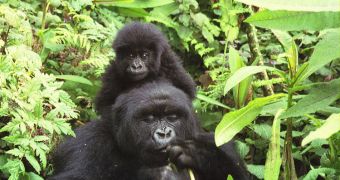In the past seven years, a population of mountain gorillas has experienced a marked improvement in numbers thanks to conservation efforts. But their situation is still tragic, as only a few hundreds of these animals exist.
This year, experts conducted a new census on the world's largest population of such gorillas, and determined that only 480 animals were alive. This is a marked improvement from the 380 that were counted during a similar survey in 2003.
Experts who conducted the survey say that the rise is very significant, of more than a quarter of the former population less than a decade ago, but add that the animals are not by far out of the woods, so to speak.
The population lives in an area consisting of no less than three national parks, spanning areas in the Central African nations of Uganda, Rwanda, and the Democratic Republic of the Congo (DRC).
Its home is the volcanic mountain ecosystem atop the Virunga Massif, say experts at the World Wildlife Fund (WWF). The conservation group adds that a group of some 300 mountain gorillas live in the Bwindi national park, in the southwestern part of Uganda.
These two are the only surviving mountain gorilla populations, numbering a total of 782 individuals after this year's count. The total number is 786, after taking into account 4 orphaned gorillas in a DRC sanctuary.
“This is vivid testimony to the commitment of the Rwanda, Uganda and DRC governments, in addition to their supporting partners including IGCP, to ensuring the sustained protection of this charismatic species,” says expert David Greer.
“The survey results provide us with an excellent demonstration of how strong law enforcement efforts put in place to safeguard flagship species can advance species conservation, benefit local communities, and provide important revenue to governments,” he adds.
The official is the African Great Ape Coordinator at the WWF. The organization is part of the International Gorilla Conservation Program (IGCP) coalition, that helped carry out the survey.
Since 2003, nine gorillas were killed in the sanctuary, and still their numbers grow by 3.7 percent. Some of the gorillas are even accustomed to human presence (habituated), and the region has been organizing eco-touristic activities to exploit this since the late 1970s.
“The mountain gorilla is the only one of the nine subspecies of African great apes experiencing a population increase,” Greer explains.
“While we celebrate this collective achievement, we must also increase efforts to safeguard the remaining eight subspecies of great apes,” he adds.
“Elsewhere in African great ape range states, government support of wildlife law enforcement efforts is shockingly weak and great apes continue to be poached in an environment of pervasive, legal impunity,” he concludes.

 14 DAY TRIAL //
14 DAY TRIAL //